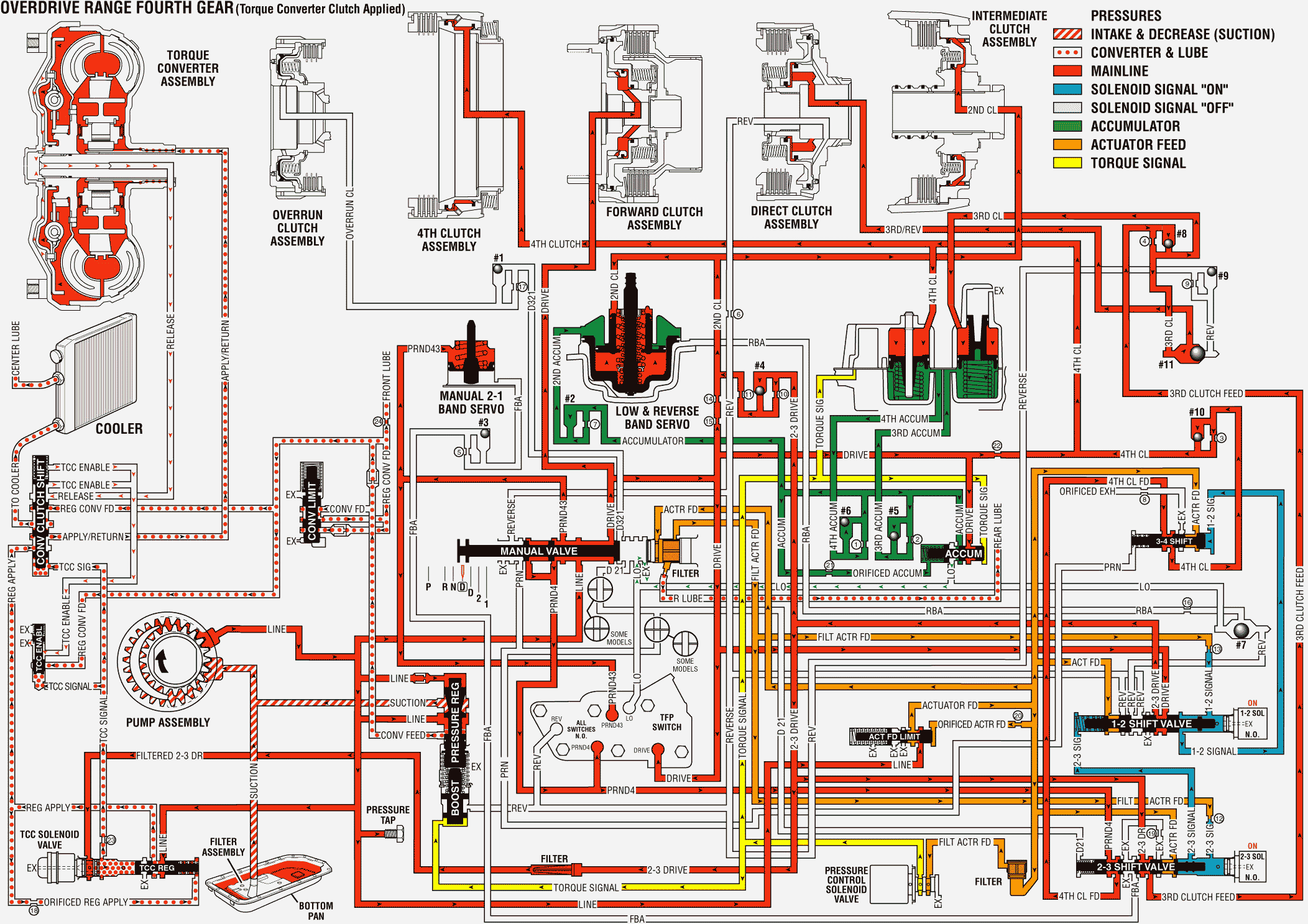For 1990-2009 cars only
In order to obtain fourth gear, the PCM receives input signals from both speed sensors, from the TP Sensor, and from other engine sensors. These signals determine when to energize the 1-2 Shift Solenoid (SS) Valve.
Manual Valve: In the Overdrive range fourth gear, line pressure from the pressure regulator valve is directed as PRND4, PRND43, and Drive fluid pressures. The PRND4 fluid pressure is directed to the Automatic Transmission Fluid Pressure (TFP) Manual Valve Position Switch Assembly and to the 2-3 shift valve. The PRND43 fluid is directed to the TFP manual valve position switch and to the manual 2-1 band servo. The Drive fluid is directed to the TFP manual valve position switch, the forward clutch, the 1-2 shift valve, and the accumulator valve.Automatic Transmission Fluid Pressure (TFP) Manual Valve Position Switch Assembly: Drive, PRND4, and PRND43 fluid pressures from the manual valve are directed to the DR, PRND4, and the PRND43 switches on the TFP manual valve position switch. This sends a signal to the PCM that the transmission is in Overdrive range.
1-2 Shift Solenoid (1-2 SS) Valve: When the 1-2 SS valve is energized, 1-2 signal fluid pressure forces the 3-4 shift valve against the spring force in order to move the 3-4 shift valve to the extreme left.
2-3 Shift Solenoid (2-3 SS) Valve: When the 2-3 SS valve is energized, 2-3 signal fluid pressure forces the 1-2 shift valve to the extreme right against a spring force.
1-2 Shift Valve: Spring force and 2-3 signal fluid pressure hold the 1-2 shift valve to the extreme right. Drive fluid pressure from the manual valve changes into 2-3 drive fluid pressure at the 1-2 shift valve. This pressure is directed to the 2-3 shift valve, to the TCC PWM Solenoid Valve, and to the intermediate (second) clutch.
2-3 Shift Valve: The PRND4 fluid pressure from the manual valve is directed through the 2-3 shift valve, to the 3-4 shift valve. The PRND4 fluid pressure changes into Fourth clutch fluid pressure at the 2-3 shift valve. The 2-3 DR fluid pressure from the 1-2 shift valve is changed into Third clutch fluid pressure at the 2-3 shift valve. This seats the #8 checkball, causing the fluid to flow through an orifice and toward the third accumulator. Third clutch fluid pressure also seats the #11 checkball, causing the fluid to flow through an orifice and toward the direct clutch.
3-4 Shift Valve: 1-2 signal fluid pressure holds the 3-4 Shift Valve to the extreme left. Fourth clutch fluid from the 2-3 shift valve changes to Fourth Clutch fluid pressure at the 3-4 Shift Valve. Fourth clutch fluid seats the #10 checkball, causing the fluid to flow through an orifice in order to apply the fourth clutch and the fourth clutch accumulator.
Low & Reverse Band Servo: Second fluid pressure is supplied to the low & reverse band servo in the same manner as the second fluid pressure is supplied to the second clutch. This fluid pressure is directed to the inner piston of the low & reverse band servo, which applies the inner piston.
Forward Clutch: Drive fluid pressure from the manual valve applies the forward clutch.
Direct Clutch: Third/Reverse pressure from the #11 checkball flows through the case and through the center support in order to apply the inner piston area of the direct clutch.
Intermediate (Second) Clutch: Second fluid pressure from the 1-2 shift valve applies the intermediate clutch. The 2-3 drive fluid pressure from the 1-2 shift valve seats the #4 checkball, causing the fluid to flow through two orifices and into the center support. This applies the Intermediate (Second) clutch. The 2-3 drive fluid pressure changes into Second apply fluid pressure at the orifices.
Fourth Clutch: Fourth clutch pressure leaves the 3-4 shift valve and seats the #10 checkball. This causes the fluid to flow through an orifice, through the case into the fourth clutch housing, and applies the fourth clutch. During the fourth clutch piston stroke, the transmission shifts into fourth gear.
Third Clutch Accumulator: Third clutch fluid pressure is also applied to the third clutch accumulator, which is encased in the accumulator housing. This moves the third accumulator piston against the spring force and accumulator fluid pressure.
Fourth Clutch Accumulator: Fourth clutch pressure is also supplied to the fourth clutch accumulator, which is encased in the accumulator housing. This moves the fourth accumulator piston against the spring and the accumulator pressure, cushioning the 3-4 shift.
Torque Converter Clutch Pulse Width Modulated (TCC PWM) Solenoid Valve: The PCM energizes the TCC PWM solenoid valve, and pressure is applied to the converter clutch shift valve. The Torque Converter Clutch (TCC) is applied. The signal pressure also acts on the torque converter clutch regulator valve, which regulates the output pressure. This controls the apply and release of the TCC.
Overdrive Range, Fourth Gear - TCC Applied

